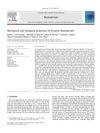Search
forLearn
5 / 5 resultslearn Thymosin Beta 4
learn Stem Cell Factor
learn Beta Polypeptide
learn Osteopontin
signaling protein that, when suppressed, may grow hair by reducing inflammation and stem cell loss
Research
5 / 1000+ resultsresearch Approach to Diagnosis of Food Allergy (Special Issue: Food Allergy; Knowledge and Points Necessary for Nursing Care) -- (Knowledge You Should Know)
Transplanted hair follicles can restore function and connect with host tissues.
research A Concise Review on Tissue Engineered Artificial Skin Grafts for Chronic Wound Treatment: Can We Reconstruct Functional Skin Tissue In Vitro?
Creating fully functional artificial skin for chronic wounds is still very challenging.

research Graft-Versus-Host Disease: Comprehensive Overview by the American Academy of Dermatology
Graft-versus-host disease is a complication where donor immune cells attack the recipient's body, often affecting the skin, liver, and gastrointestinal tract.

research Mechanical and Biological Properties of Keratose Biomaterials
Keratose, derived from human hair, is a non-toxic biomaterial good for tissue regeneration and integrates well with body tissues.

research Organoids in Skin Wound Healing
Skin organoids help improve wound healing and tissue repair.
Community Join
5 / 76 resultscommunity About Verteporfin but not about hair
Verteporfin treatment shows promise for hair regeneration and reducing scar tissue in hair transplants. Some users plan to try verteporfin with hair transplants, and it may also be combined with PRP in future experiments.
community Got a microscope camera. Here’s the difference between healthy and miniaturized hair
A user who shared progress pictures of their scalp using a microscope camera, demonstrating the difference between healthy and miniaturized hair. Various explanations for the cause of this were discussed, such as DHT build-up in scalp sebum causing an autoimmune response leading to inflammation and eventual hair loss, with some suggesting a do-it-yourself treatment involving adding ascorbic acid powder to shampoo.
community Dutasteride Infertility Debunked: Low T causes true infertility.
Dutasteride and finasteride may temporarily affect semen quality but are unlikely to cause permanent infertility. The Kim et al. study is criticized for poor methodology, and many prefer hair retention over potential fertility concerns, using treatments like dutasteride, finasteride, and minoxidil.
community 3 month into 2.5mg dutasteride - no hairs fall out of my head anymore
OP reports that after 3 months on 2.5mg dutasteride, their hair has stopped falling out and is thick again, but they are considering stopping due to potential mood and energy side effects. Other users discuss experiences with finasteride, dutasteride, and side effects, with some suggesting lower doses or alternative treatments like topical applications.

community FCE 28260: A Forgotten 5α-Reductase Inhibitor
FCE 28260 (PNU 156765), an under-explored 5α-reductase inhibitor, showcases promising results in research by Giudici et al., outperforming well-known treatments like Finasteride in reducing the conversion of testosterone to DHT. Its superior efficacy, demonstrated through lower IC50 values in both natural and human recombinant enzyme studies, suggests it could offer more effective management of DHT-related conditions. Additionally, its lower molecular weight hints at better potential for topical application, potentially offering advantages in treating conditions such as androgenic alopecia. Despite its potential, it has not advanced in development, possibly due to financial limitations, leaving its therapeutic prospects and side effect profile largely unexplored.